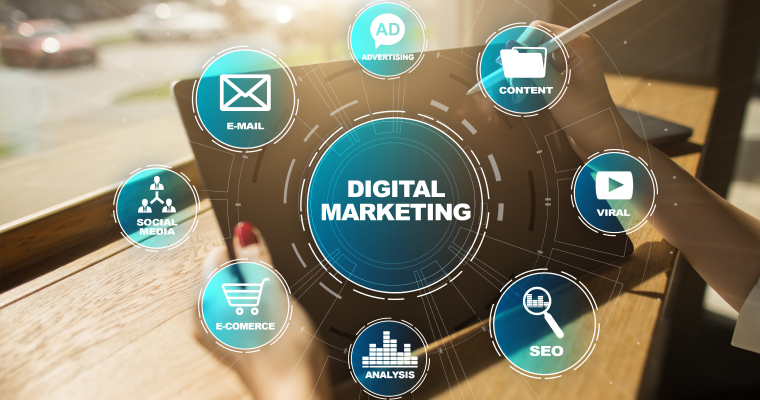
Welcome to the digital age, where we conduct our work (and personal) lives over webcam, order our groceries online, and argue with our relatives through social media.
It’s a brave new world. Savvy business owners are doing everything they can to create a strong digital presence. But while digital marketing is certainly worth your time and investment (especially now), you’re missing out on tremendous returns by neglecting to include traditional media with the rest of your media strategy.
Traditional media has been around since the birth of advertising. We could technically stretch the definition all the way back to the first hieroglyphs (Best Mummification in Cairo!) but for modern-day purposes, “traditional marketing” is generally defined as any existing marketing channel preceding digital. Some examples of traditional marketing include:
If you’re drafting your next marketing budget, here’s why traditional media deserves a seat at the table.

There’s no sugarcoating the fact that digital media consumption has gained a lot of ground at the expense of traditional over the last two decades. But according to viewing numbers, it still hasn’t surpassed several forms of traditional media. In fact, in reports just prior to COVID-19, traditional TV was still beating online TV across all markets while broadcast radio remained ahead of streaming in a vast majority of markets.
And when you take a look at COVID-19 numbers, you can see that older generation demographics such as Gen Xers and Boomers turn to traditional media channels like broadcast TV and radio more often than several digital audio and video platforms, such as Pandora, Spotify, and Hulu. Even millennials are showing a surprising resurgence in consumption of physical press.
The narrative that digital has killed traditional forms of media is simply untrue. The reality is that people are now consuming media across traditional and digital channels—and not at the expense of one another. People are posting on social media while watching TV, researching products while at the store, reading print publications, and following up online to access more content. This behavior has been coined “second screening”.
It’s this blend of online and offline behavior that indicates traditional is still very much a viable advertising route.
One of the greatest conveniences of digital marketing is that it results in neat, trackable data. You may think that traditional advertising methods lack the same level of granularity, but with the help of digital analytics you can track your traditional spend just as efficiently.
For example, with television and print assets, you can create a unique URL, promo code or phone number that will track the amount of leads from these mediums. These gateways will end up taking users to the same digital landing page or phone number as your online ads, but thanks to your analytics and call-tracking software, every lead is counted as a traditional acquisition.
Another method of tracking traditional media is by monitoring branded search traffic. Traditional advertising is a great method for generating brand awareness, so monitor traffic during the same period of time you are running a branded campaign and see whether it generates a spike in branded search visits. Sophisticated ad agencies (like Agital!) have tools to track TV and radio spots in real time to find correlations between broadcast ads and branded searches.
Out-of-home (OOH) advertising is trickier to track, but that makes the solution all the more interesting to understand. Thanks to advances in digital billboards and smart technology, advertisers can now pull what’s known as Variable Adjustment Index (VAI). This uses metrics from eye-tracking tests with smart goggles and averages out ad impressions based on daily estimated circulation to determine how many people likely looked at your ad. Advertisers also use metrics related to cell phone location data and traffic movement patterns to tie billboard exposure back to in-store physical visits.
In the event that you are worried about targeting, most publishers offer circulation/viewing figures, as well as audience demographics, to help you decide if their audience aligns with your target audience. As you can see, there’s no reason to think that traditional campaigns can be any less transparent than digital.
Research continues to show that traditional advertising is one of the most effective methods for generating awareness and ROI based on its broad reach.
For example, when compared to social media F2C (firm-to-consumer) and C2C (consumer-to-consumer) communication, traditional advertising was found to outperform both at growing new customer acquisition, brand awareness, and brand consideration.
In another study on consumer ability to recall ad campaigns, research showed that digital media performed lowest of all, peaking at only 30%, while traditional forms of media like television and radio performed best with recall rates of up to 60% for consumer products and services. Traditional channels have also proven themselves to generate the highest ROI while being some of the most underrated channels, even among advertisers!
When it comes to print, direct mail can drastically outperform digital means, with an average household response rate hovering around 5%. Compare that to 0.6% for email, 0.6% for paid search, and 0.4% for social media. With the right kind of messaging, that kind of response rate can generate tremendous ROI for your brand.
So why is traditional media so effective? It has to do with the institutions we trust.
When you market through traditional media, you engender more trust and familiarity with your brand. Things like creating a prominent billboard on a busy freeway, airing a commercial broadcast during a local sports game or printing an ad in a prominent local magazine help you integrate your brand into a surrounding community and culture. Digital real estate just doesn’t hold the same kind of sentimental value that we associate with the real, tangible places, and institutions in our lives.
Research backs this up. Consumers find that advertising through traditional media is the most trustworthy, with 61% of consumers trusting TV, print (58%), radio/podcast (45%), and out-of-home (42%) compared to the least trustworthy advertising mediums: online (41%) and social media (38%). Studies also show that physical advertising can generate more stimulation and desirability, and in the case of direct mail, drive more behavior than digital media.

We should never consider traditional and digital marketing as pitted against one another. Both methods of advertising work best when they’re able to work in tandem. Combining channels from online and offline creates a multiplier effect that amplifies your reach, recall and impact.
The trick is understanding the right media mix for your brand. There’s no one-size-fits-all approach, so brands often enlist the expertise of professional marketing agencies to help dive deep into audience research, pull insights, map customer journeys, and plan effective media mixes.
In fact, over 95% of marketers agree that a healthy multi-channel mix is important when creating campaigns. Need some proof? Here are some excellent concepts that show how mixing traditional and digital can create magic.
Ryan Reynolds has put out some of the best tongue-in-cheek advertising of the last several years (in my humble opinion), just check out his spots for the Deadpool franchise and his own Aviation Gin brand. He added to that reputation earlier this year by taking out a full-page spot with the NYTimes prior to the Super Bowl. In the ad, he explains how Mint Mobile is taking the money they would have invested in a Super Bowl commercial and using it to give new customers free service for three months. Now, it could have gotten decent mileage on its own, but by leveraging social media to promote the traditional spot, Mint Mobile ended up with a huge amount of exposure and positive press at a fraction of the price.
The San Francisco SPCA wanted to educate more people on spaying and neutering their pets, so naturally, their first instinct was to place pet condom dispensers in dog parks. The experiential aspect of this marketing campaign shocked and interested people, enough that they opened the condom strips to find informational brochures outlining the importance of getting your pets fixed. Thanks to some help from social media, the “pet condom dispenser” was picked up by many news outlets, became the #1 trending topic on Reddit and generated over 30,000 site visits to the SPCA.
We’re big believers in integrated marketing because we’ve seen that it works! We collaborated with ADOT to develop the Gold Star campaign, an effort to encourage more Arizonans to update their travel IDs. We created OOH and digital banners as well as flyers and brochures to help get the message out about the importance of getting your Gold Star. Combining our online and offline approach lead to more than 5 million impressions and a 51% increase in travel IDs being issued!
So yes, while digital is important, traditional can be just as important to consider when crafting your overall campaign. If you’d like to know how traditional media fits with your brand, get in touch with the Agital today!
